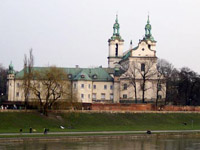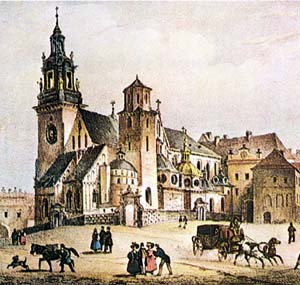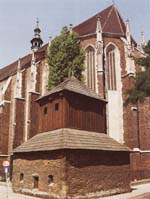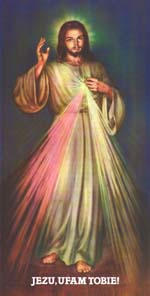The sanctuary of Sain John Paul II is situated in the Lagiewniki neighborhood of Krakow, some four kilometers
south of the
Old town historical center. It’s accessible on
foot from the Sanctuary of Divine Mercy after a five minutes
walk. The actual shrine of Saint John Paul II is the
octagonal Church of the Relics (Kosciol Relikwi) also
referred to as the lower church because it takes up the
central area of the basement story of the complex’s main
edifice which contains also the Church of Saint John Paul II
upstairs – the upper church.

Skalka is situated a twenty to twenty five minutes’ walk
southward from the Rynek Glowny central square of Krakow,
beautifully situated on the Wisla river bank near the Wawel
Royal Castle. It’s Poland’s oldest shrine with unique
significance for the Polish history and the nation’s
spirituality. The Skalka Sanctuary is revered as the
location of Saint Stanislaus’s martyrdom in 1079 and the
center of the veneration of the Polish most important martyr
and one of the patron saints of Poland. The present Skalka
church, dedicated to Saint Michael the Archangel and Saint
Stanislaus the Bishop, dates from the mid-18th century,
being the fourth temple built on the site. Visitors can
still see three dark spots believed to be St. Stanislaus's
blood on the wall next to the martyr’s altar which itself
exhibits a timeworn lump of wood said to be a piece of the
11th-century altar step onto which the martyr's blood
spilled in 1079.
The church of the ancient Cistercian Abbey in the Mogila
area
of Krakow
is the home of the Sanctuary of the Holy Cross which
enshrines two pieces of the True Cross that Saint Helena
discovered in 328. One has been held in the Mogila Abbey
from time immemorial though unfortunately no document
certified its genuineness beyond doubt. So in 1961 Krakow’s
Sanctuary of the Holy Cross has obtained an authenticated
fragment of the True Cross from the Santa Croce basilica in
Rome.

The Krakow Cathedral on the Wawel Hill is not only the
hallowed mother church of the Krakow archdiocese but also a
cluster of shrines. First and foremost, it boasts the
sanctuary of
Saint
Stanislaus
the Bishop and Martyr in the form of a mausoleum holding his
relics in the centre of the nave. Also, there is an
altar-shrine of Saint Jadwiga of Poland in the eastern arm
of the ambulatory of the Wawel Cathedral. And The Chapel of
Our Lady, with entrance in the middle of ambulatory, is the
place of the daily adoration of the Blessed Sacrament
although
the faithful can see
the venerated image of the Gracious Mother of God only on
special occasions and otherwise this historic icon remains
deposited in the building of the cathedral treasury.
Sanctuary of Our Lady of Sorrows (Sanktuarium Matki
Boskiej Bolesnej)
A chapel of the centrally located massive medieval church of
Krakow’s oldest Franciscan monastery enshrines the
miraculous image of the Virgin Mary of circa 1440
known as Our Lady of Sorrows. People in distress have
flocked to her sanctuary for centuries. In 1908 the picture
of Our Lady of Sorrows, often also called the Doleful
Benefactress of Krakow, has been decorated with a papal
crown. The church of Saint Francis at Franciszkanska street
contains also the shrines of Blessed Salomea of Poland,
Blessed Aniela Salawa, and Blessed Jakub Strzemie.
Sanctuary of Our Lady of the Rosary
(Sanktuarium Matki Boskiej Rozancowej)
The
Dominican church of the Holy Trinity in Krakow at Stolarska street, a block from the Old Town's Rynek Glowny
central square, has been known for its shrine of Our Lady of
the Rosary since 1668. The Gothic basilica, which dates from
the end of the 14th century, also enshrines the sanctuary of
Saint Jacek Odrowaz who is venerated beyond Poland as Saint
Hyacinth O.P. The painting venerated in
the Chapel of Our Lady of the Rosary of
the Basilica of the Holy Trinity has been brought to Krakow
from Rome and is a copy of the famous image of the Blessed
Virgin Mary with the baby Jesus,
worshipped
in Basilica di Santa Maria Maggiore. The picture of Our
Lady of the Rosary in Krakow’s Basilica of the Holy Trinity
has been decorated with papal crowns in 1921.
The fresco known as Our Lady of Piasek dates from circa 1500
and tradition attributes its origins to a supernatural
intervention. Once adorning the outside wall of the Basilica
of the Visitation of the Blessed Virgin Mary at Karmelicka
street, now it's enshrined in its own chapel. From the
outset the image the Madonna of Piasek has become renowned
for mercies obtained through the intercession of Our Lady.
Among others, Poland’s king Jan III Sobieski maintained that
his victory over the Ottoman Empire in the Battle of Vienna
was attained through the prayers in Krakow’s Sanctuary of
Our Lady of Piasek. The image of Our Lady of Piasek has been
canonically crowned with papal crowns in 1883.
Sanctuary of Our Lady of Loreto (Sanktuarium Matki
Boskiej z Loreto)
Krakow’s Sanctuary of Our Lady of Loreto is situated in a
side chapel of the Capuchin church at 11 Loretanska street,
a short walk westward from the Rynek Glowny central square.
The chapel of 1719 is a copy of the famous Santa Casa di
Loreto, worshipped as the family house of the Blessed Virgin
Mary which has been transferred from the Holy Land to Italy
in the 13th century.
Sanctuary of Our Lady of the Redemption of Slaves
(Sanktuarium
Matki Bozej od Wykupu Niewolnikow)
The miraculous picture of Our Lady of the Redemption of
Slaves, also known as the image of Our Lady of Freedom, is
enshrined in the high altar of the Church of SS. John the
Baptist and John the Evangelist at sw. Jana street, one
block north from Krakow's Rynek Glowny central square.
According to tradition, the veneration of the 16th-century
image began in 1633 and since then
Our Lady of the Redemption of Slaves
has been considered the protectress of prisoners and
hostages, and now generally in the case of any enslavement:
kidnapping as well as addictions or alcoholism. In 1965
Archbishop Karol Wojtyla, the future Pope John Paul II,
crowned the picture of Our Lady of the Redemption of Slaves
with papal crowns.

Sanctuary of Our Lady of Consolation (Sanktuarium Matki Bozej
Pocieszenia)
The shrine of Our Lady of Consolation takes up a portion of
the medieval cloister of the Augustinian friars adjacent to
the gothic Church of Saint Catherine
in the Kazimierz historic district of Krakow,
at Augustianska street and Skaleczna street, close to the
Skalka Sanctuary. Early in the 16th century a large mural of
the Blessed Virgin Mary of Consolation was painted on
its wall. In 2000 the Krakow image of the Mother of
Consolation has been canonically crowned with papal crowns
previously blessed in Vatican by Pope John Paul II.
Sanctuary of Our Lady of Perpetual Help (Sanktuarium
Matki Bozej Nieustajacej Pomocy)
The Church of Our Lady of Perpetual Help is situated some
three kilometers south of the Rynek Glowny central square.
Its high altar enshrines a copy of the miraculous picture of
Our Lady of Perpetual Help, also known as Our Lady of
Perpetual Succour, the 15th-century Byzantine icon
worshipped in Rome’s church of San’Alfonso di Liguori. Since
1952 the continuous Novena to Our Lady of Perpetual Help has
taken place in the Krakow sanctuary at Zamoyskiego street.
Sanctuary of Saint Joseph (Sanktuarium Swietego Jozefa)
A side altar in the church of Immaculate Conception of the
Blessed Virgin Mary at 18 Rakowicka street enshrines the
17th-century large picture of Saint Joseph which became
famous for graces attained through the intercessions of the
husband of the Blessed Virgin Mary. The veneration of the
painting started practically immediately on its arrival to
Krakow in 1669. The relics of Saint Raphael Kalinowski are
to be found
in the vestibule of the church,
on the right-hand side of the entrrance. The relics of Saint
Albert Chmielowski were buried here from 1948 to 1983.
The Ecce Homo Sanctuary (Sanktuarium Ecce Homo)
The Ecce Homo Sanctuary at 10 Woronicza street is the center
of the veneration of Saint Albert Chmielowski. The high
altar of a little modern church enshrines
the reliquary with the saint's relics while the relics of
Blessed Sister Bernardina are placed next to it.
The shrine owes its name to the title of the picture
painted by Saint Albert Chmielowski prior to 1904 when he
still was Adam Chmielowski, an artist. The painting, now
displayed at the high altar of
the Ecce Homo Sanctuary,
depicts tortured Jesus Christ crowned with thorns, clothed
in scarlet robe and holding a staff.
Sanctuary of Our Lady of Fatima (Sanktuarium Matki Bozej
Fatimskiej)
The sanctuary is situated in a rather unusual modern church
of 1977
in the Bienczyce area of the Nowa Huta district. The church,
dedicated to the Mother of God, Queen of Poland, is
popularly called “Arka Pana”: the Lord’s Ark. This
church has always symbolized the struggle of Catholics
against the godless communist regime in the second half of
the 20th century. The Sanctuary of Our Lady of Fatima has a
form of a chapel imitating a grotto under the church's high
altar It enshrines the venerated statue of the Blessed
Virgin Mary, which is a copy of the famous statue of Our
Lady of Fatima, donated by Portuguese Catholics. In 1992
Pope John Paul II granted a Canonical Coronation to the
image of Our Lady of Fatima in the Lord’s Arc in Krakow.
Sanctuary of Our Lady of Plaszow (Sanktuarium Matki Bozej
Nieustajacej Pomocy)
Since 1931 the parish church of the Holiest Heart of the
Lord Jesus in the
Plaszow right-bank industrial district of Krakow has
enshrined the venerated image of Madonna that dates back to
the second half of the 15th century. The picture symbolizes
the patronage of the Virgin Mary over marriages, maternity,
and family life. Cardinal Karol Wojtyla, the future Pope
John Paul II, has designated the Plaszow church as a focal
point for the veneration of Our Lady, the patroness of
families.







